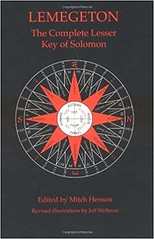 Ars Theurgia: The second book of the work known as the Lemegeton, or Lesser Key of Solomon. The word theurgia comes from a Greek root meaning “sacramental rite” or “mystery” Theurgy itself is a type of magick that involves the invocation of beneficent spirits. It was originally practiced by the neo-Platonists. During the Renaissance, theurgy came to have the connotation of white magick, as opposed to the Goetic arts, which were generally viewed as black magick. The Ars Theurgia contains an extensive list of demons associated with the points of the compass. These demons are arranged in hierarchies, and each hierarchy is associated with one of the cardinal directions. An infernal emperor oversees each of the cardinal directions, and the demonic princes, kings, and dukes who serve beneath him are in turn associated with aspects of that direction, such as northwest and south by southeast. The demons of the Ars Theurgia that are associated with a specific direction are thought to rule over that portion of the compass and to be found in that direction when called. Their position is thought of as being fixed. In addition to these fixed points, the Ars Theurgia also contains the names of a number of wandering spirits, which it describes variously as princes and dukes. These wandering princes are tied to no specific point of the compass, but range with their courts from place to place.
Ars Theurgia: The second book of the work known as the Lemegeton, or Lesser Key of Solomon. The word theurgia comes from a Greek root meaning “sacramental rite” or “mystery” Theurgy itself is a type of magick that involves the invocation of beneficent spirits. It was originally practiced by the neo-Platonists. During the Renaissance, theurgy came to have the connotation of white magick, as opposed to the Goetic arts, which were generally viewed as black magick. The Ars Theurgia contains an extensive list of demons associated with the points of the compass. These demons are arranged in hierarchies, and each hierarchy is associated with one of the cardinal directions. An infernal emperor oversees each of the cardinal directions, and the demonic princes, kings, and dukes who serve beneath him are in turn associated with aspects of that direction, such as northwest and south by southeast. The demons of the Ars Theurgia that are associated with a specific direction are thought to rule over that portion of the compass and to be found in that direction when called. Their position is thought of as being fixed. In addition to these fixed points, the Ars Theurgia also contains the names of a number of wandering spirits, which it describes variously as princes and dukes. These wandering princes are tied to no specific point of the compass, but range with their courts from place to place.
The demons of the Ars Theurgia are presented as spirits of the air, and they are all thought to possess an airy nature that prevents them from being clearly seen with the naked eye. As a result, they are invocated into a scrying glass or a specially prepared crystal known as a “show-stone.” Notably, a crystal show-stone was also employed by Dr. John Dee in his work with the Enochian spirits.
Although they are tacitly associated with the element of air due to their subtle natures, many of the spirits of the Ars Theurgia are also associated with other elements. They tend also to be bound to the hours of either the day or the night, and most courts contain demons affiliated with each.
The exact date of the material contained within the Ars Theurgia is unknown. Within the Lemegeton, only the book known as the Almadel has an internal date establishing at least when it was copied. This fixes the writing of the version of the Almadel contained within the Sloane collection at the British Museum to 1641. Of the five books traditionally included in the Lemegeton, the Goetia is arguably the oldest, and there are strong connections that can be drawn between the material in the Goetia and that of the Ars Theurgia. Most significantly, both books employ the use of demonic seals or sigils in the invocation of their respective spirits. Notably, all of the major spirits in the Ars Theurgia appear in Johannes Trithemius's Steganographia. The descriptions of most of these spirits, including their directional affiliations and the numbers of their dukes and sub-dukes, are similar if not identical between these two texts. This places the establishment of this particular system of spirits to at least the end of the 1400s, if not earlier.
SEE ALSO:
SOURCE:
The Dictionary of Demons: Names of the Damned by Michelle Belanger
